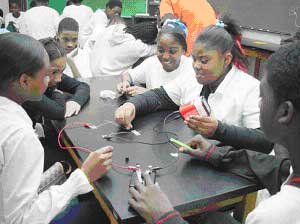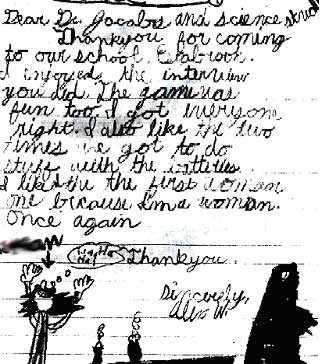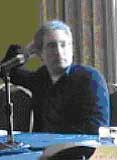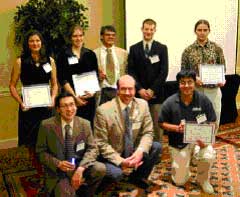Forum on
Education of The American Physical Society
Summer 2005 Newsletter
Undergraduates Celebrate the World Year of Physics! Gary White, American Institute of PhysicsThe celebration of Einstein's Miracle Year is about half over, but it seems as though physics students nationwide have already indulged in a full year or more of activities. Loads of outreach events, regional physics meetings, and research events mark this year as an exceptionally good time to be doing physics. OUTREACH ENGAGES THOUSANDS IN SCIENCE Imagine a roomful of kids eagerly connecting wires to batteries and bulbs to see if their prediction for making light is right. If this image seems unlikely to you, just ask the physics students at Chicago State University for help in visualizing it. Geraldine Cochran, Tim Vanderleest and Virginia Hayes wrote the outreach proposal funded by the SPS through the Marsh White Outreach Award program, with guidance from Professors Mel Sabella and Justin Akujieze. They have a knack for this stuff, including middle school and high school visits, a rocket-launch, and science fair assistance. To see more about their efforts and those of other groups, see http://www.spsnational.org/programs/mwrecipients04.htm
HUNDREDS OF UNDERGRADUATE PHYSICISTS MEET IN 2004-05 Want to know where a great swath of future physics graduate students can be found? Try an SPS zone meeting where undergraduate physics majors share their research, listen to cutting edge physics talks, and socialize. There were 17 zone meetings across the country this past year like the one below in Louisiana, complete with student presentations from nine campuses, a public Einstein lecture, and a crawfish boil!
HOW DO YOU GET YOUR STUDENTS INVOLVED? Who can resist a Top Ten List, especially when it chock-full of ways to get your students engaged in the World Year of Physics? Try some of these ideas out for size: Top ten ideas for celebrating the World Year of Physics: 10) Solve a physics problem to win prizes; see the Physics Challenges at http://scitation.aip.org/tpt/ 9) Put a WYP message and the website in your email salutations. www.physics2005.org 8) Sponsor a local physics trivia contest, http://www.physics2005.org/events/physicstrivia/questions.pdf 7) Get a free Einstein poster as long as supplies last; email us sps@aip.org 6) Join in the WYP discussion threads at The Nucleus, www.compadre.org/student 5) Conduct your own science demonstration event in a local school or mall. Get ideas here: http://www.spsnational.org/programs/mwrecipients05.htm 4) Attend an SPS Zone meeting (http://www.spsnational.org/societynews/meetings.htm)---there were 17 last year, so there's probably one near you this year 3) Check out the WYP events calendar, or post your own event at http://www.physics2005.org/events/index.html . There's something for everyone, from drama and music to pumpkin flinging and open houses to conferences and renowned lecturers. 2) Go shopping for WYP T-shirts, WYP promotional kits, cool multi-LED pens, etc. Email us at sps@aip.org or see http://www.spsnational.org/societynews/2005WYP_shirts.htm And the number 1 way to celebrate the World Year of Physics is: 1) Detect gravity waves! Sign up for Einstein@Home; see http://einstein.phys.uwm.edu/ for details. (next article) Gary White received his Ph.D. in nuclear theory at Texas A & M University (TAMU) in 1986, but would rather talk about his more recent work on the physics of Spandex. Lately, his interests have also migrated towards pedagogy, especially the use of science research as a teaching and outreach tool. In addition to a 3-year stint teaching mathematics at TAMU, he has taught physics and astronomy at Northwestern State University of Louisiana, and now is the Director of the Society of Physics Students and the Assistant Director of Education for the American Institute of Physics. |





